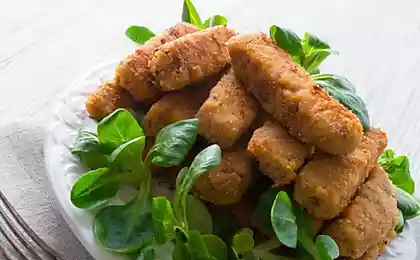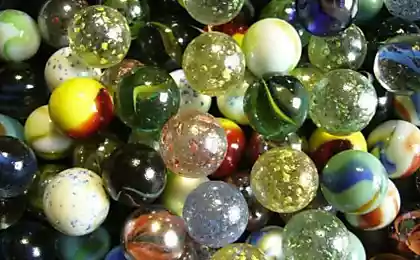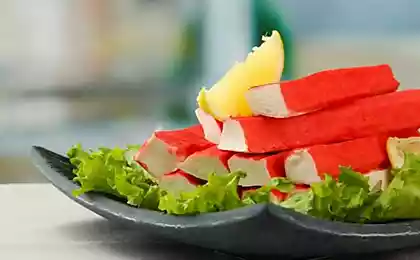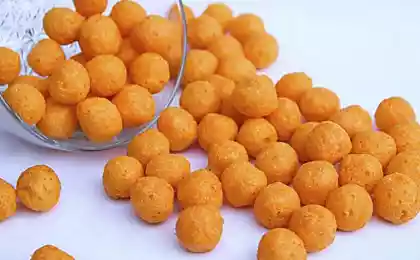987
How do fish balls, crab sticks, etc.
Writes blogger i-cherski:
During the tour to Singapore our small, but warm company for some reason, journalists were invited to inspect the factory for the production of fish balls. The meaning of this visit to the factory came to me at once - because not every factory producing food dares to show reporters from what really it's all done. But here everything was presented very honestly and openly, so below a small report with pictures.
28 photos
1. To begin with happy children. Children desperately poster show how much they love the products of the factory. And by the way do not lie - in the many local cafes, I watched analogues of these children, eats different versions of beads with a big appetite.
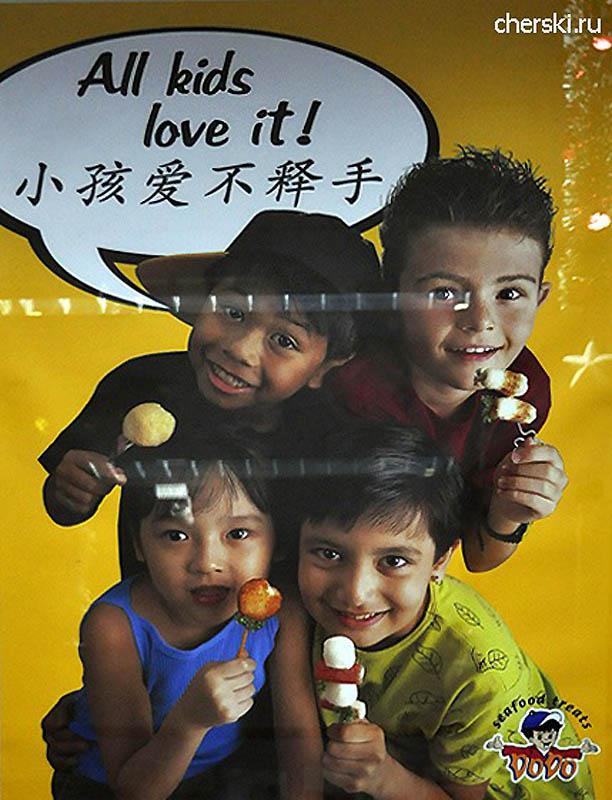
2. A lot of versions of reality, with a lot of all sorts of flavors, additives and others. And the packaging itself is quite nice.

3. The tour began with a tasting. It is unlikely that I wanted to try something out of this again, but the taste is quite tolerable. Maybe we're just not used to this, and besides, we ate it without sauces, spices and others. But if you pour something right, it can and does delicacy.

4. In order to penetrate the secrets of the process, we go down to the dungeon.

5. And get into the room forced sterilization. Then be able to pass only those who carefully washed his hands ...

6. ... exactly as instructed

7. and then wiped his hands of these very same according to the instructions.

8. ... and simultaneously bathed in some caustic solution and without sterile boots

9. In addition, the walls are covered with special cushions to collect dust from the clothes \ villi

10. And also guide - where the same without her. True, we did not use rollers because we were given a brand new, sterile gowns.
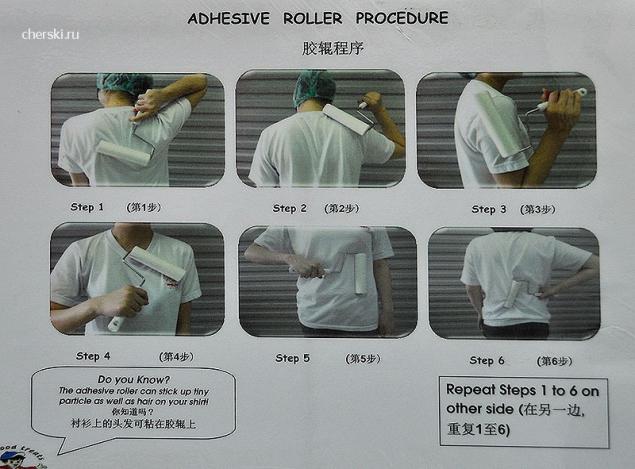
11. And the holy of holies - the raw material warehouse. I naively expected to see it live fish. Yeah, I'm funny. Certainly, these briquettes in colored packages were once fish.

12. But after a meeting with all the fish trawler looks:

13. Of course, in this way it will have a few. There's even branded packaging will not save.
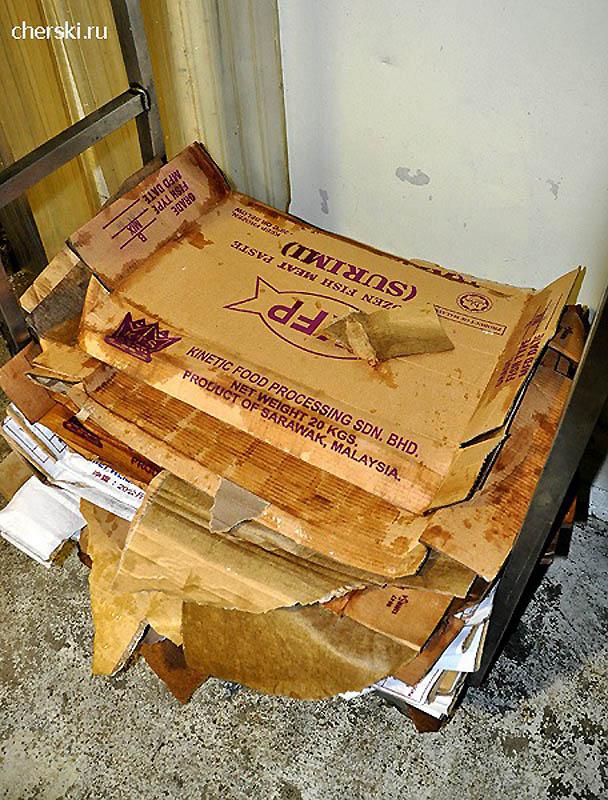
14. Therefore, minced meat is thawed, milled and subjected to a number of further procedures to get out of it tens names are different in taste, shape and composition of the product.

15.

16. Here there is a batch. In the stuffing added some secret agents, giving consistency to future balls rubber balls of various densities.

17. Here hordes of balls to soak in the different solutions

18. And then processed further in different ways and temperatures

19. Some are here as a result of such sausages or something else
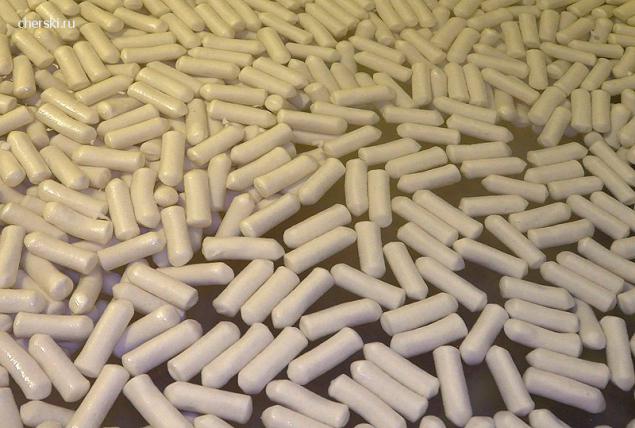
20. Here they have something sprinkled and frozen. Packed somehow manually - maybe automatic line will cost more manual labor.

21.
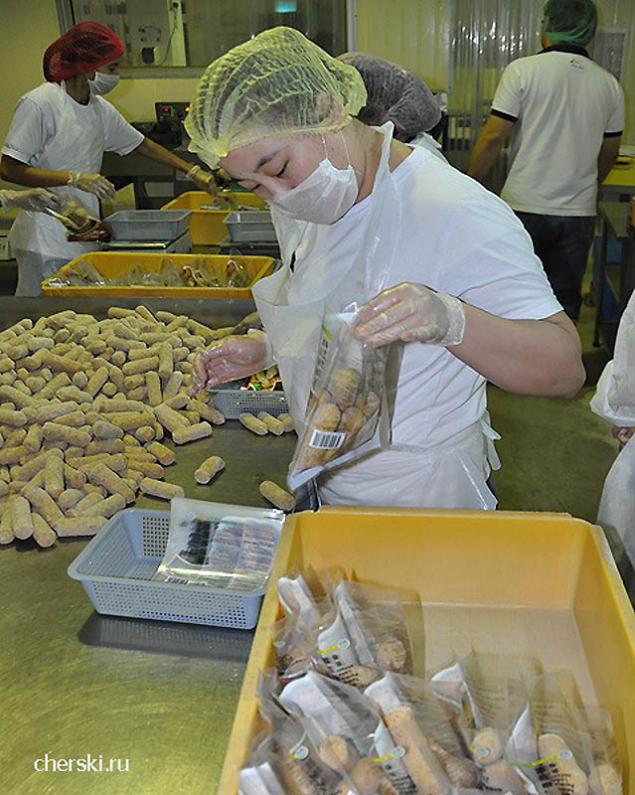
22. "Where is the crab sticks?" -Ask You? But they are manufactured here. The feedstock is the same, slightly more additives. The mass is rolled into thin sheets, which are then twisted into a layered tubes.

23. Here we are up to color and cut.

24. Next, the future of the rods attached to the desired color

25. Then they are cut and wrapped

26. The fall in boxes

27. and then packs

28. And actually everything. You may ask, why did I disappoint you in the crab sticks origin? Well, it just so that's a fact of life. These kinds of foods make up a large proportion of our daily diet. And will be even greater because people, too, more and eating less. And of course, making food from the fact that it's not like - technology of the future and technology gains. Sell chips much cheaper than potatoes, and about the production process it is better not to know. Do delicacies from stuffing too certainly cheaper than from the live fish. And the output of the factory obtained 25 tons per day, available absolute majority even with low incomes. For the quality of the balls can be no doubt - in Singapore this well is very strict, and the product must go through a bunch of inspections and certifications before being admitted to the market, and even more so in other countries for export. We certainly too strict, but in Singapore, there is theft and corruption. We have. Therefore, in the production of the same food may well be laid on the roof of mandatory spending, officials and other filth, as well as certainly something else soprut at the very factory. What is added to products to make up for all this, just better not to know. Probably why Singaporeans are not afraid to let us its not the most aesthetic production. There's even the most inquisitive journalist finds no horror.

Source:
During the tour to Singapore our small, but warm company for some reason, journalists were invited to inspect the factory for the production of fish balls. The meaning of this visit to the factory came to me at once - because not every factory producing food dares to show reporters from what really it's all done. But here everything was presented very honestly and openly, so below a small report with pictures.
28 photos
1. To begin with happy children. Children desperately poster show how much they love the products of the factory. And by the way do not lie - in the many local cafes, I watched analogues of these children, eats different versions of beads with a big appetite.

2. A lot of versions of reality, with a lot of all sorts of flavors, additives and others. And the packaging itself is quite nice.

3. The tour began with a tasting. It is unlikely that I wanted to try something out of this again, but the taste is quite tolerable. Maybe we're just not used to this, and besides, we ate it without sauces, spices and others. But if you pour something right, it can and does delicacy.

4. In order to penetrate the secrets of the process, we go down to the dungeon.

5. And get into the room forced sterilization. Then be able to pass only those who carefully washed his hands ...

6. ... exactly as instructed

7. and then wiped his hands of these very same according to the instructions.

8. ... and simultaneously bathed in some caustic solution and without sterile boots

9. In addition, the walls are covered with special cushions to collect dust from the clothes \ villi

10. And also guide - where the same without her. True, we did not use rollers because we were given a brand new, sterile gowns.

11. And the holy of holies - the raw material warehouse. I naively expected to see it live fish. Yeah, I'm funny. Certainly, these briquettes in colored packages were once fish.

12. But after a meeting with all the fish trawler looks:

13. Of course, in this way it will have a few. There's even branded packaging will not save.

14. Therefore, minced meat is thawed, milled and subjected to a number of further procedures to get out of it tens names are different in taste, shape and composition of the product.

15.

16. Here there is a batch. In the stuffing added some secret agents, giving consistency to future balls rubber balls of various densities.

17. Here hordes of balls to soak in the different solutions

18. And then processed further in different ways and temperatures

19. Some are here as a result of such sausages or something else

20. Here they have something sprinkled and frozen. Packed somehow manually - maybe automatic line will cost more manual labor.

21.

22. "Where is the crab sticks?" -Ask You? But they are manufactured here. The feedstock is the same, slightly more additives. The mass is rolled into thin sheets, which are then twisted into a layered tubes.

23. Here we are up to color and cut.

24. Next, the future of the rods attached to the desired color

25. Then they are cut and wrapped

26. The fall in boxes

27. and then packs

28. And actually everything. You may ask, why did I disappoint you in the crab sticks origin? Well, it just so that's a fact of life. These kinds of foods make up a large proportion of our daily diet. And will be even greater because people, too, more and eating less. And of course, making food from the fact that it's not like - technology of the future and technology gains. Sell chips much cheaper than potatoes, and about the production process it is better not to know. Do delicacies from stuffing too certainly cheaper than from the live fish. And the output of the factory obtained 25 tons per day, available absolute majority even with low incomes. For the quality of the balls can be no doubt - in Singapore this well is very strict, and the product must go through a bunch of inspections and certifications before being admitted to the market, and even more so in other countries for export. We certainly too strict, but in Singapore, there is theft and corruption. We have. Therefore, in the production of the same food may well be laid on the roof of mandatory spending, officials and other filth, as well as certainly something else soprut at the very factory. What is added to products to make up for all this, just better not to know. Probably why Singaporeans are not afraid to let us its not the most aesthetic production. There's even the most inquisitive journalist finds no horror.

Source:

